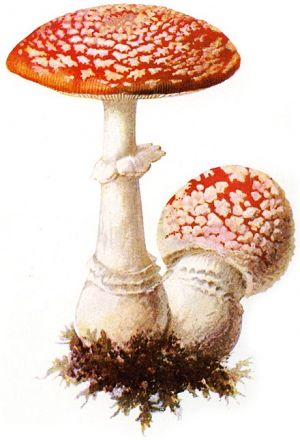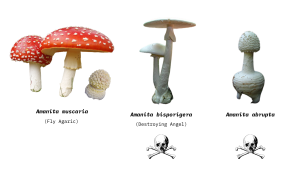Amanita muscaria
Amanita muscaria (also known as fly agaric or fly amanita Figure 1) is a psychoactive mushroom that grows widely in the northern hemisphere. The fly agaric is a large white-gilled, white-spotted, usually red mushroom that is one of the most recognizable and widely encountered in popular culture 🍄. The mushroom is arguably[1] the Soma-plant in Vedic religion[2] as it is noted for its hallucinogenic properties, which derive from its primary psychoactive constituents ibotenic acid and muscimol[3].
Although classified as poisonous, reports of human deaths resulting from its ingestion are extremely rare. This is further compounded by several recorded cases of low dose ingestion without issue[4]. The key to its safety is differentiation from the Destroying Angel and the Death Cap, parboiling—which weakens its toxicity and breaks down the mushroom's psychoactive substances and careful dosage[5]. To this day, the dried mushroom is used as a medicinal ingredient, and as a substitute for alcohol in parts of Russia as a narcotic by the Koryak people[6].
Differentiation
One of the major dangers of amanita muscaria is misidentifying it as a different species of mushroom. Several other mushrooms in the genus amanita are toxic and cause 90% of all fatal mushroom poisonings see figure 2. One such mushroom, the amanita phalloides, better known as the death cap, contains α-amanitin and β-Amanitin, both of which are extremely potent RNA polymerase II and RNA polymerase III inhibitors which damage virtually every tissue in the body. As the name suggests, the amanita muscaria contains the chemical muscarine, a muscarinic acetylcholine agonist which is known to cause seizures; however, the mushroom contains very low amounts that are highly unlikely to pose any significant harm.
Identification
Found in forests from July to October, this Amanita has a symbiotic relationship with various trees, and is most often found under pines, spruces, and birches. The problem with the identification of the Amanita (and this is a general mushroom rule) is that rain may alter its appearance considerably by washing away its patches or draining its vibrant red to a paler shade. With these more superficial characteristics erased, it can easily be mistaken for an innocuous or edible look-alike. Beware of look-alikes!
Ingestion
There is a long history of edibility of the prepared mushroom in Japan[7]. Traditional knowledge highlighted that in its raw state this mushroom is toxic and inebriating and therefore did not ingest it as such. They consumed it only after certain preparations: "Dried, soaked in brine for 12-13 weeks, rinsed in successive washings until the water became clear. They came out alabaster white and indeed are translucent like alabaster. Prepared thus for savouring during the long winter evenings, they are delicious, excellent as hors d'oeuvres"
Pharmacology
The active ingredients of the Amanita muscaria are ibotenic acid, muscimol, and muscarine. The first two ingredients act on the nervous system as GABAA agonists within thirty minutes to two hours after ingestion, causing dizziness, lack of coordination, delirium, spasms, and muscular cramps. These symptoms are temporary and subside within four to twenty-four hours.
Toxicity
It may be harmful to combine Amanita muscaria constituents with other GABAergic depressants such as alcohol, benzodiazepines or barbiturates. Ibotenic acid is also known to be a neurotoxin, acting via the NMDA receptor and metabotropic glutamate receptor. It is wise to dry amanita muscarias in the oven or purchase pre-dried amanitas to ensure the ibotenic acid concentration is as low as possible.
Amanita muscaria mushrooms are not known to be addictive or dependence-forming, and reports even show that desire to redose goes down with usage, though there is no research on this topic.
Preperation
In light of the potential toxicity it has been shown to best reduce nausea and vomiting by making a tea from dried amanita muscaria. The preparation techniques have been shown "no significant variation in the likelihood of experiencing psychoactive effects[8]".
References
- ↑ Soma and "Amanita muscaria" Author(s): John Brough Source: Bulletin of the School of Oriental and African Studies, University of London, Vol. 34, No. 2 (1971), pp. 331-362 Published by: Cambridge University Press on behalf of School of Oriental and African Studies Stable URL: http://www.jstor.org/stable/612695
- ↑ Soma: Divine Mushroom of Immortality by R. Gordon Wasson by Sungazer Press (first published January 1st 1968)
- ↑ Hallucinogenic Species in Amanita Muscaria. Determination of Muscimol and Ibotenic Acid by Ion Interaction HPLC M. C. Gennaro a , D. Giacosa a , E. Gioannini a & S. Angelino a a Università di Torino Dipartimento di Chimica Analitica Via P. Giuria , 5 10125, Torino, Italy Published online: 23 Sep 2006.
- ↑ Buck, R. W. (1963). Toxicity of Amanita muscaria. JAMA: The Journal of the American Medical Association, 185(8), 663. doi:10.1001/jama.1963.03060080059020
- ↑ Neuropharmacological Investigations on Muscimol, a Psychotropic Drug Extracted from Amanita Muscaria* A. Sco~TI DE CA~OHS, F. LIPPA/~INI and V. G. LONGO Laboratori di Chimica Terapeutica, Istituto Superiore di Sanit&, Roma, Italia Received March 10, 1969
- ↑ Russian Use of Amanita muscaria: A Footnote to Wasson's Soma Author(s): Ethel Dunn Source: Current Anthropology, Vol. 14, No. 4 (Oct., 1973), pp. 488-492 Published by: The University of Chicago Press on behalf of Wenner-Gren Foundation for Anthropological Research Stable URL: http://www.jstor.org/stable/2740856 . Accessed: 16/02/2015 19:02
- ↑ "Amanita muscaria": The Gorgeous Mushroom Author(s): Christal Whelan Source: Asian Folklore Studies, Vol. 53, No. 1 (1994), pp. 163-167 Published by: Nanzan University Stable URL: http://www.jstor.org/stable/1178564 . Accessed: 18/06/2014 00:23
- ↑ Revisiting Wasson's Soma: Exploring the Effects of Preparation on the Chemistry of Amanita Muscaria Kevin Feeney a a Department of Anthropology , Washington State University , Pullman, WA Published online: 20 Sep 2011.

